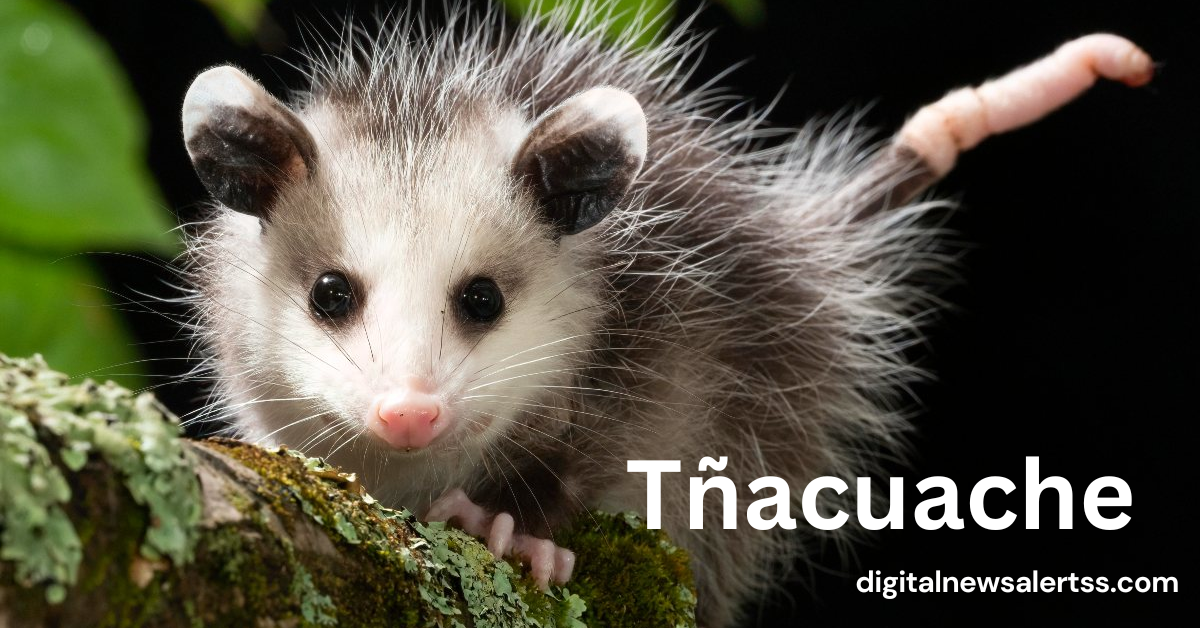The tñacuache, often known as the opossum or possum, is a fascinating creature that has intrigued people across different cultures for centuries. Native to the Americas, this marsupial has a unique place in the animal kingdom, belonging to the Didelphidae family, which includes over one hundred species.
In the United States, the tñacuache is often recognized for its nocturnal habits, distinctive appearance, and role in the ecosystem. This article will explore everything you need to know about the tñacuache, from its biology and behavior to its cultural significance and how it benefits the environment.
Whether you’re a wildlife enthusiast, a curious homeowner, or someone looking to understand this creature better, this comprehensive guide will provide insights beyond what’s already available. We aim to humanize the tñacuache, making it easy to understand and appreciate this often misunderstood animal.
What is a Tñacuache?
The tñacuache is a common name for the opossum, a marsupial native to the Americas. The name “tñacuache” is often used in Mexico and Central America, while in the United States, it is commonly referred to as the opossum or possum. The most well-known species is the Virginia opossum (Didelphis virginiana), which is the only marsupial found in North America north of Mexico.
Physical Characteristics
Tñacuaches are medium-sized mammals with a distinct appearance. They have grayish fur, a long, pointed snout, and a prehensile tail, which they use for gripping branches and balancing. Their bodies are about the size of a house cat, with a length ranging from 21 to 36 inches, including the tail. They weigh between 4 to 14 pounds, depending on the species and environment.
Their eyes are dark and shiny, giving them a somewhat ghostly appearance at night. One of their most notable features is their mouth, filled with 50 sharp teeth, the most of any North American land mammal.
Behavior and Habits
Tñacuaches are nocturnal creatures, meaning they are most active during the night. They are known for their slow and deliberate movements but can be surprisingly fast when threatened. Despite their somewhat sluggish appearance, tñacuaches are excellent climbers, using their sharp claws and prehensile tails to navigate trees.
One of the most famous behaviors of the tñacuache is “playing possum.” When threatened, they can mimic the appearance and smell of a sick or dead animal to deter predators. This act is not a conscious decision but an involuntary response, similar to fainting.
Diet
Tñacuaches are opportunistic feeders, which means they eat a wide variety of foods. They are omnivores, consuming fruits, vegetables, insects, small animals, and even carrion. In urban areas, tñacuaches are often seen scavenging through trash cans, looking for scraps of food.
Their varied diet makes them beneficial to the environment as they help control insect populations and clean up dead animals. They also play a role in seed dispersal, as they consume fruits and spread the seeds through their droppings.
The Ecological Role of the Tñacuache
Tñacuaches play a crucial role in the ecosystems they inhabit. Their diet helps control populations of pests such as insects and rodents, and their scavenging habits help clean up the environment by consuming dead animals.
Pest Control
One of the most beneficial aspects of the tñacuache is its appetite for pests. They consume a significant number of insects, including ticks, which are known to spread Lyme disease. Studies have shown that a single tñacuache can eat thousands of ticks in a week, making them an important ally in controlling tick populations.
Seed Dispersal
Tñacuaches also contribute to the ecosystem by dispersing seeds. As they consume fruits, they spread the seeds through their feces, helping to promote the growth of plants and trees. This natural process supports biodiversity and helps maintain healthy ecosystems.
Carrion Consumption
Another important ecological role of the tñacuache is their consumption of carrion (dead animals). By eating carrion, tñacuaches help clean up the environment and reduce the spread of disease. This scavenging behavior is crucial for maintaining a balanced ecosystem.
The Tñacuache in Culture and Folklore
The tñacuache has a rich history in various cultures, particularly in Mexico and Central America, where it is often featured in folklore and mythology.
Mythological Significance
In Mesoamerican mythology, the tñacuache is considered a trickster figure. One popular story tells of how the tñacuache brought fire to humanity. According to the legend, the tñacuache stole fire from the gods by hiding a burning ember in its tail. This tale explains why the tñacuache’s tail is hairless, as it was scorched by the fire.
Symbolism
The tñacuache is often seen as a symbol of survival and resilience due to its ability to thrive in various environments and its unique defense mechanism of playing dead. In some cultures, the tñacuache is also associated with fertility and renewal.
Modern Cultural References
In modern times, the tñacuache continues to be a subject of interest in popular culture. It has appeared in various films, cartoons, and literature, often portrayed as a clever and resourceful character. The tñacuache’s unique appearance and behaviors have made it a favorite among wildlife enthusiasts and a popular subject for nature documentaries.
The Tñacuache and Human Interaction
Tñacuaches are often misunderstood by people, particularly in urban areas where they are sometimes seen as pests. However, understanding their behavior and ecological role can lead to more harmonious coexistence between humans and tñacuaches.
Common Misconceptions
One of the most common misconceptions about tñacuaches is that they are aggressive and carry diseases. While it’s true that tñacuaches can carry diseases like any wild animal, they are generally not aggressive and prefer to avoid confrontation. Their defense mechanism of playing dead is a testament to their preference for avoiding conflict.
Another misconception is that tñacuaches are dirty animals. In reality, tñacuaches are quite clean and spend a significant amount of time grooming themselves. Their scavenging habits may make them appear dirty, but they play a crucial role in keeping the environment clean.
How to Coexist with Tñacuaches
If you encounter a tñacuache in your yard or home, it’s important to remain calm and avoid provoking the animal. Tñacuaches are generally harmless and will move on if left alone. If a tñacuache has taken up residence in your home, it’s best to contact a wildlife removal service to safely relocate the animal.
To prevent tñacuaches from entering your home or yard, make sure to secure trash cans and remove any food sources that may attract them. Sealing off entry points to your home can also help prevent tñacuaches from getting inside.
Benefits of Having Tñacuaches Around
While tñacuaches may not be the most popular neighbors, they offer several benefits. As mentioned earlier, they help control pest populations and clean up the environment. By allowing tñacuaches to coexist in your area, you contribute to a healthier and more balanced ecosystem.
The Tñacuache’s Role in Conservation
Tñacuaches are not currently considered endangered, but they face threats from habitat loss, road accidents, and human persecution. Conservation efforts are focused on protecting their habitats and promoting coexistence with humans.
Habitat Preservation
Preserving natural habitats is crucial for the survival of tñacuaches and other wildlife. Urbanization and deforestation are major threats to their habitats, and conservationists are working to protect the areas where tñacuaches live.
Wildlife Corridors
One of the ways to protect tñacuaches is by creating wildlife corridors. These are protected pathways that allow animals to move between different habitats safely. Wildlife corridors help reduce the risk of road accidents and provide tñacuaches with access to food and shelter.
Public Education
Educating the public about the benefits of tñacuaches and how to coexist with them is also an important aspect of conservation. By dispelling myths and misconceptions, people can develop a greater appreciation for these animals and their role in the ecosystem.
Fun Facts About Tñacuaches
- Ancient Lineage: Tñacuaches are one of the oldest surviving mammals, with ancestors dating back to the time of the dinosaurs.
- Playing Dead: The phrase “playing possum” comes from the tñacuache’s unique defense mechanism, where it mimics the appearance and smell of a dead animal to avoid predators.
- Low Body Temperature: Tñacuaches have a lower body temperature compared to other mammals, which makes them less susceptible to diseases like rabies.
- Marsupial Pouch: Like kangaroos, female tñacuaches have a pouch where they carry and nurse their young.
- Solitary Creatures: Tñacuaches are solitary animals and prefer to live alone, except during the breeding season.
- Short Lifespan: In the wild, tñacuaches have a relatively short lifespan, typically living only 2 to 4 years.
Conclusion
The tñacuache is a remarkable creature that plays a vital role in the environment. Despite being misunderstood and sometimes viewed as a nuisance, tñacuaches offer numerous benefits, from controlling pests to cleaning up the environment. By understanding their behavior and ecological importance, we can learn to coexist with these fascinating animals and appreciate the unique contributions they make to the world around us.
Whether you encounter a tñacuache in the wild or your backyard, remember that they are an important part of the ecosystem and deserve our respect and protection.
FAQs about Tñacuache
What should I do if I find a tñacuache in my yard?
If you find a tñacuache in your yard, it’s best to leave it alone. Tñacuaches are harmless and will likely move on if undisturbed. If the animal appears injured or is causing problems, contact a local wildlife removal service.
Do tñacuaches carry diseases?
While tñacuaches can carry diseases like any wild animal, they are generally not a significant threat to humans. Their lower body temperature makes them less likely to carry rabies.
How can I prevent tñacuaches from entering my home?
To prevent tñacuaches from entering your home, secure trash cans, remove food sources, and seal any entry points around your house. This will reduce the likelihood of tñacuaches seeking shelter in your home.
Are tñacuaches aggressive?
Tñacuaches are generally not aggressive and prefer to avoid confrontation. If threatened, they may play dead as a defense mechanism rather than attack.
What do tñacuaches eat?
Tñacuaches are omnivores and eat a wide variety of foods, including fruits, vegetables, insects, small animals, and carrion. In urban areas, they may scavenge through trash for food.
How long do tñacuaches live?
In the wild, tñacuaches typically live 2 to 4 years. Their lifespan can be shorter due to threats such as road accidents and predators.
Can tñacuaches climb trees?
Yes, tñacuaches are excellent climbers. They use their sharp claws and prehensile tails to navigate trees, where they often seek food and shelter.



